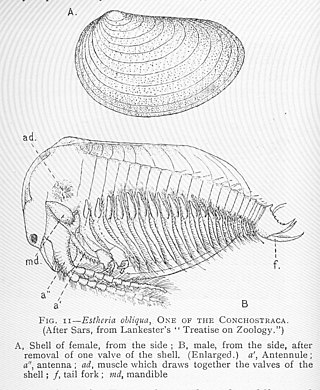
Ailuravus is a genus of prehistoric rodents in the family Ischyromyidae.

Batrachiderpeton is an extinct genus of nectridean tetrapodomorphs within the family Diplocaulidae; it was a basal member of the family. The type species is B. reticulatum and was found in a coal field in Northumberland, England at a locality that also yields the remains of Anthracosaurus russelli. A second species is also known: B. lineatum.

Phenacodontidae is an extinct family of large herbivorous mammals traditionally placed in the “wastebasket taxon” Condylarthra, which may instead represent early-stage perissodactyls. They lived from the late early Paleocene to early middle Eocene and their fossil remains have been found in North America and Europe. The only unequivocal Asian phenacodontid is Lophocion asiaticus.
The Strawn Formation is a geologic formation in Texas and New Mexico. According to Cummins (1891), the formation was named from the town of Strawn in Palo Pinto County, Texas. It preserves fossils dating back to the Carboniferous period.
The Yegua Formation is a geologic formation in Texas. It preserves fossils dating back to the Paleogene period.

The Thaynes Formation is a geologic formation in Montana and Idaho, United States. It was recently elevated to group status, as the Thaynes Group.
The Taraises Formation is a geologic formation in northern Mexico. It preserves fossils dating back to the Early Cretaceous, including ammonites.
The Balumtun Sandstone is a geologic formation in Chiapas, Mexico. The formation is up to 760 metres thick, and consists of gray sandstone, that were deposited during the Upper Aquitanian stage of the Early Miocene.
The Juchipila Formation is a geologic formation in Mexico. It preserves fossils dating back to the Neogene period. Closely corresponding to the other Hemphillian faunal assemblages of North America, it is significant for understanding the palaeofauna of Miocene and Pliocene central Mexico.
The Mazantic Shale is a geologic formation in Chiapas, Mexico. It was deposited during the Early Miocene (Aquitanian). The formation comprises dark gray shales that were deposited in a marine environment. It preserves fossils, such as the turtle Allaeochelys liliae. Amber has been recovered from it.
The El Cien Formation is a geologic formation in eastern Baja California Sur state, Mexico.
The Carbonera Formation is a geologic formation in Mexico. It preserves fossils dating back to the Berriasian to Hauterivian stages of the Early Cretaceous period.
The Tacubaya Formation is a geologic formation in Aguascalientes, Mexico. It preserves fossils dating to the Pleistocene epoch.

Colubroidea is a superfamily of snakes in the clade Colubroides that includes Colubridae, with some studies splitting Colubridae into multiple families that make up Colubroidea. Historically, Colubroidea also included other caenophidian snakes such as cobras and vipers, as these snakes form a clade. However these groups are now divided into several distinct, but related, families. Zaher et al. (2009) proposed to redefine Colubroidea for colubrids and related families, while designating Colubroides as the group containing vipers and cobras as well as colubroids. The ReptileDatabase considers Colubroidea to be composed of Colubridae and the members of its sister group, Elapoidea, and does not recognize the division of Colubridae into multiple families.

Lioestheria is an extinct genus of clam shrimp that thrived from the Carboniferous to the Cretaceous. They fed on detritus, being very small slow moving, nektonic organisms that filter fed as they floated. They have been found in both marine and freshwater environments.
Copecion was a genus of early herbivorous mammals that was part of the family Phenacodontidae. It reached 6 to 12 kg and was similar in size and morphology to Ectocion. Both these herbivorous ungulates likely occupied similar ecological niches.
Palaeophasianus is an extinct genus of flightless Geranoididae birds that lived in North America during the Eocene period. Robert Wilson Shufeldt classified Palaeophasianus as a galliform when he described it in 1913. However it was transferred to Cracidae in 1964 by Pierce Brodkorb, while Joel Cracraft in 1968 placed it in Gruiformes.







